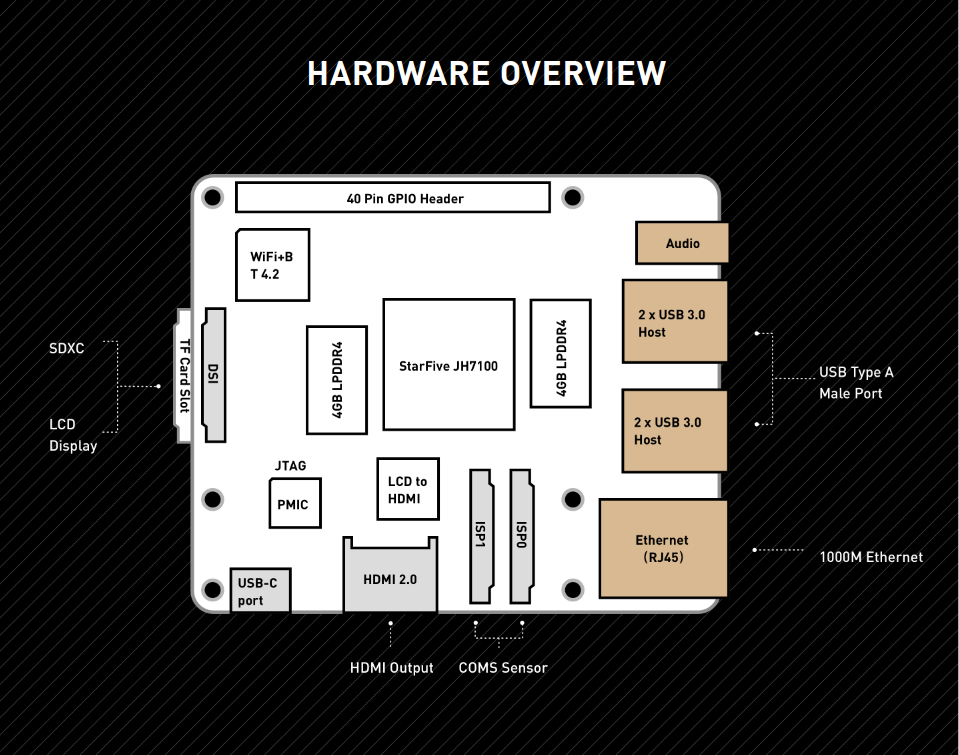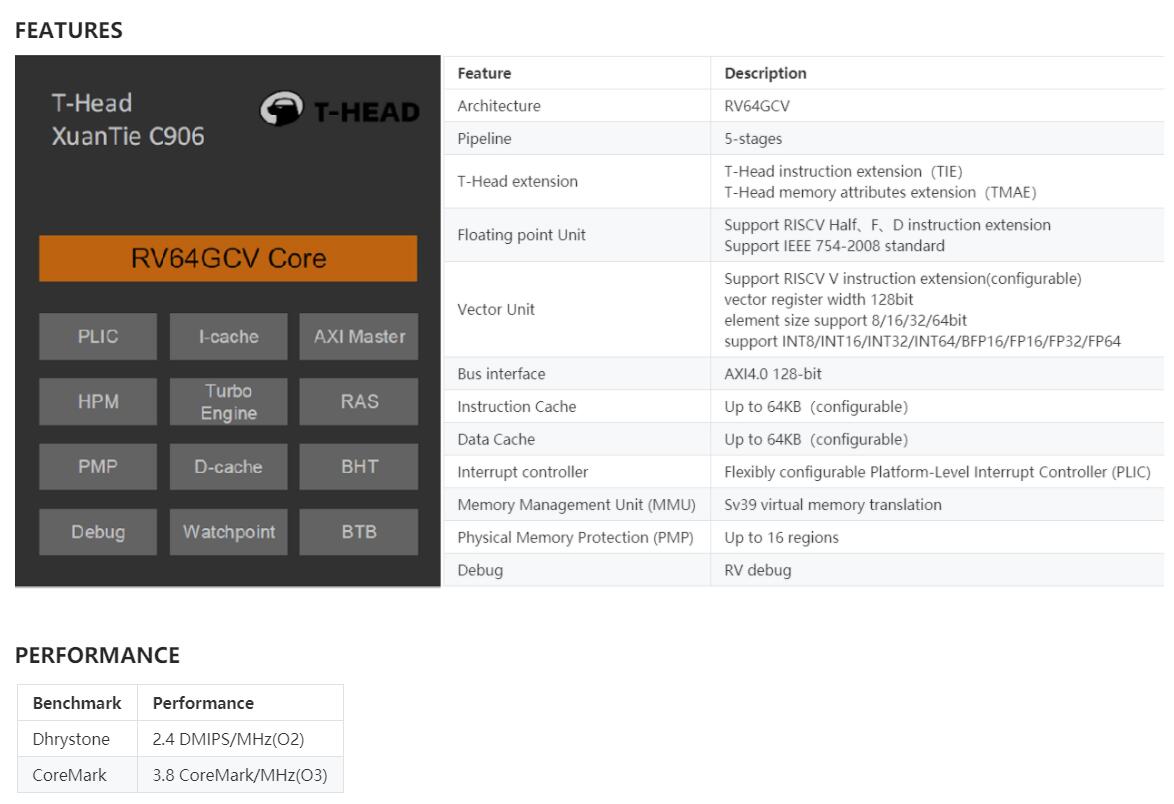We’re all familiar with the fable of the boiling frogs, unable to sense the change they’re (literally!) immersed in. Enthusiasts of RISC-V architecture may be encountering the same right now: late 2020 gave us a steady stream of new hardware announcements, but we may not have a great sense of us since the hardware isn’t always possible to order yet. Let’s review some of the upcoming products in this market, duly nothing that products can change or get canceled before they even ship.
We had two major new families of entries in the iOT category. Both use the RISC-V to drive WiFi and Bluetooth radio stacks. Bouffalo Lab’s BL602 is available in quantity now. Starting around $2.50 for a module with multiple development boards in the $5-$10 range (including Pine64’s Nutcracker for PineCone and the DoIt DT-BL10), this chip starts with a core from SiFive and has 802.11 b/g/n and Bluetooth 5. The upcoming BL-702 family adds Zigbee radios. There is enough compute resources (CPU, RAM, Timers, etc.) that you can build your own software right onto the radio chip via their multitasking OS and open development kits. You may recognize this as the basic model popularized by Espressif in their ESP8266 in recent years.
Espressif also embraced RISC-V with their upcoming ESP32-C3 family. It’s interesting that this chip doesn’t even get a distinct name at this point as Espressif apparently sees the CPU core as only a small part of the product. Still, by volume, the ESP32-C3 is likely to become an extremely popular choice.
Moving up a step computationally, we enter more traditional chips and single-board computers. Alibaba’s Xuantie 910 is widening into a family of chips. The C906 is being marketed for more entry level class, but still featuring a load of I/O, multiple cores, support for the still-not-ratified Vector extensions, and more. Press releases tend to mix up the 910 and the 906, but they both seem pretty hot. In late January, anAndroid Open Source Port of C910 was demonstrated. Embedded specialists Sipeed have announced a C906 development board that’ll run Debian and that starts at $12.50. If Sipeed does for that what they’ve done for GD32V and K210, we should see lots of interesting SBC projects from them.
Rios is bringing us a claimed competitor to the Raspberry Pi called the PicoRio. It’s coming inthree stages:
- PicoRio 1.0 is a headless, four-core RV64GC that’s capable of running Linux at 500Mhz. It’s been used from 2020H2 to an expectation of beta in 2021H1.
- PicoRio 2.0 adds Imagination’s PowerVR GE7800 XE series GPU, which may finally bring a GPU-capable RISC-V development board into casual hobbyist price points.
- PicoRio 3.0 strives to bring the performance to be comparable to a tablet or desktop computer.
Another entry in the Pi-class of hardware, though not at Pi Price, is the Beagle V from the group that brought us the famed Beagle Bone. It uses two of SiFive’s U74 cores at 1Ghz includes 8GiB of LPDDR4 RAM, gigabit Ethernet, an 802.11n Wi-Fi + Bluetooth 4.2 chipset, and a dedicated hardware video transcoder supporting H.264 and H.265 at 4K and 60fps.The system also offers four USB 3.0 ports, a full-size HDMI out, 3.5mm conventional audio jack, and a 40-pin GPIO header. As a snack for those interested in AI applications, it also features a Tensilica Vision VP6 DSP for machine-vision applications, a Neural Network Engine, and a single-core NVDLA (Nvidia Deep Learning Accelerator). 
Core provider SiFive is bolting Freedom U740 cores to a min-ITX design in HiFive Unmatched. X16 PCIe expansion, 16GB of DDR4 RAM, NVME M.2 slot, Gigabit ethernet, and four cores at 1.4Ghz should make this a entry-level desktop-class system, including host-CPU class of building for native applications at full scale. For professional developers, the $665 entry ticket should be more appealing that the $999 for the board’s predecessor, Unleashed.
The PicoRio V1 and Unmatched have already slipped from Q4 into 2021.
Still, while we’re not bathing in fresh alternatives to the GD32V and K210, we have several alternatives on the proverbial launching pad and several options to bring excitement into lives and toolboxes of RISC-V aficionados.
What do you see coming up? What are you most anxious to work with?

mark says:
Of the SBCs you mention, I hope Beaglebone get things working. The board will eventually come with a GPU from Imagination – for me, it’s a pity that it won’t be RISC-V ISA. Still, with a number of competitive CPUs now, we will surely begin to see GPUs being designed and fabbed.
Pine64 have also announced an intention to develop a RISC-V SBC, and a name – PineOne. They’ve got good form – I’m confident they’ll do it well. I’m excited about their Nutcracker initiative with their PineCone too.
Sunil Shenoy’s return to Intel from SiFive perhaps signals hope for Intel-designed RISC-V chips. Perhaps even something RISC-V to take on Apple’s M1?
What I’d really like to see though, is a company design a competitive RISC-V board to slot into a Fairphone, and put it up on Kickstarter to gauge enthusiasm.
Robert Lipe says:
Hi, Mark.
Here a few weeks later (sorry) the situation has changed slightly. This year’s chip shortage is going to beat us all up pretty badly.
The BeagleV is just starting (like, within days – to ship to the developers. International shipping (that doesn’t cost more than the product) as it is, The U74-based design is breathing with two cores, but without the unratified (V)ector or (B)itmap extensions. It’s not clear how many of the StarFive parts will make it to other vendors this year, but it’s clear that another round of silicon will be needed before mass production. This was part of the plan and why they’ve limited availability.
The D1 from Allwinner that’s used in the board designed by Sipeed is also on the shipping dock. As I write this, they’re still tweeting about shipping individual orders. The Allwinner D1 contains Alibaba T-Head C906 core and DOES include pre-release (V) and (B) extensions. The data sheets and relevant source trees jwere just unveiled late Wednesday and I’m typing this on Saturday.
One of the twists from Allwinner on D1 is that they don’t expect to have silicon to make available to other vendors this year. This means their own reference board – that’s closer to the Beagle-V than a MAIX Bit – may be available from a few different manufacturers and sales/support organizations, but it doesn’t seem likely that we’ll see the related form factors optimized for different markets this year. With memory prices as they are, nobody is really making eye contact about a $12.50 board running Linux – with an MMU – this year using D1.
I didn’t mention Pine above, though I’m a fan of the Pine64 company. (An nutty-tasting order from them arrives this week, in fact…) When they teased about the board that got the name PineOne on Twitter and in IRC, it seemed more likely to be based on the Allwinner part than on any U74 design. So while they (and one more from RVBoards) may be able to make the D1 reference boards, I think their ability to get the raw D1s is going to be a problem in the short term. (Anyone with tips on this, please do share!)
With the core (compiler, library, hypervisors, operating systems, etc.) just receiving hardware by early May or so, it seems we’ll have some delightful choices soon. It’s been fascinating to be part of projects that would normally be clouded with NDA instead have team members on the groups talking with open source infrastructure developers and more surprisingly, each other.
With Pine’s experience with power management for PineTime, Pine64, and PinePhone(all ARM), they’d seem a natural for your Fairphone project. Power management is a definite issue for one of these two board (the required fan isn’t shown in the pictures) so it may need to be some other part.
We share many of the same wishes. We just need to be patient. I’m looking forward to my tracking numbers. 🙂
mark says:
Thanks for the update about the D1. I wonder why they’re going with the 906 and not the 910? (No doubt you saw the recent clip of AOSP running on three XuanTie 910 cores – exciting times!)
Do you know whether the Vector extension has been ratified yet? I just keep hearing that it’s close to being finalized.
🙂 I guess the revolution that is an Open Source ISA produces the revelation in hardware collaboration that we’ve seen in software development for the last generation: an industry so cloaked in privacy for technical advantage learning the benefits of working together… nothing short of staggering, really.
Counter to the chip shortage issue that you mention – I read that the new RISC-V Espressif chips seem to be debuting on schedule… Some good news, at least!
Good luck with your nutty-tasting adventure! I hear LoRa is coming on well… and that there has been some progress with reverse engineering the software that the PinePhone’s modem uses!
:O I’ve just read on Mastodon that Alan Pope has received his BeagleV to start playing with!
Robert Lipe says:
D1 is the developer reference board. It’s ostensibly a low cost design, though in this time of memory shortage, isn’t going to be quite so low cost. C910 is a more high-end design.
(V) knows it’s in hot demand. It’s still on track for final draft in a couple of months, followed by the 45 day public comment and vote. Since it’s been so carefully scrutinized by industry experts, simulated, emulated, and tested, the actual passages is *expected to be* just the wheels turning.
It’s indeed pretty amazing to watch all the tooling surrounding RISC-V spin up just really in the last five years. By tinkering with it for years before that in academia, we’ve seen scores (hundreds?) of independently verified cores. Many made it to FPGA or “real” silicon. Whether you need a $.10 part to control an appliance (but need a sane assembler, compiler, debugger, etc…) or – soon – a four core, out of order, 1.5Ghz+ board for ~$150USD, it’s covered. It’s pretty nifty.
My contact with Espressif says they’re on track, but they disappeared from Ali and my order at Mouser keeps getting pushed back. Since they’re not reliant on external (DDR4) RAM like some of these boards are, they’re more in a “choose your own adventure” path. Just a few days ago, AI Thinker announced they’re spinning that part into All The Form Factors: https://www.cnx-software.com/2021/04/24/ai-thinker-esp32-c3-modules-compatible-esp8266-esp32/
The BL602 charge – and especially on Lora – is being led by https://twitter.com/MisterTechBlog. His twitter feed is good to follow if you’re into that combination.
BeagleV’s started landing in mass on Monday. I need to check the shipping status on mine. 🙂 BeagleV and D1 are pretty exciting.
Cheers!